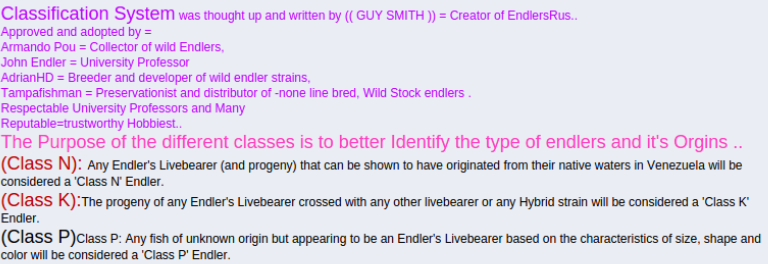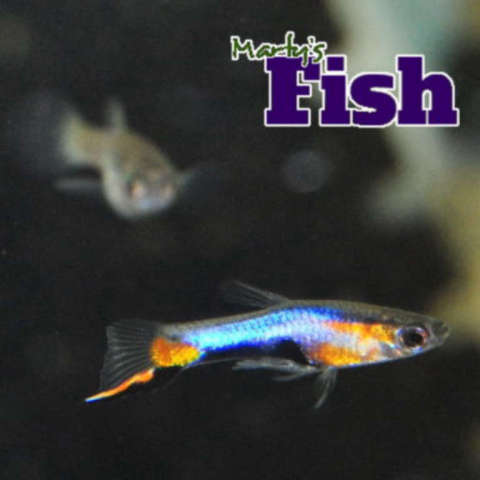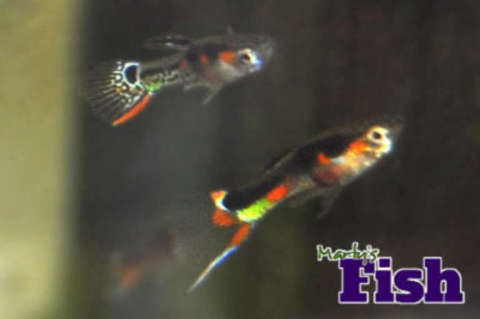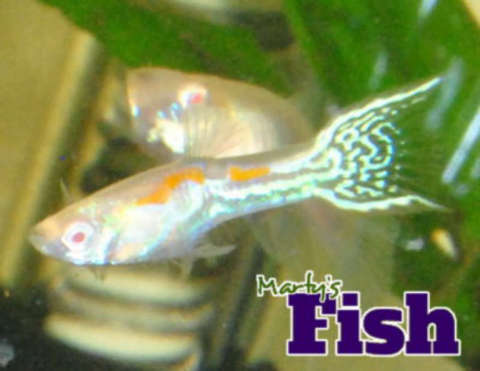First of all, the topic of the ECS and Endlers and guppies has been and probably will always be a highly disputed topic. The purpose of this article is to help explain why there are so many differing opinions and to help clarify some of the confusion. We would like to encourage anyone that has further information concerning the topic or differing point of views to leave a comment.
The Endler Classification System or (ECS) was developed to help protect the purity of the Endler strains originally brought back from Venezuela by Armando Pou in the late 1990’s and early 2000’s.
This system was developed because Endlers (Poecilia wingei) could easily cross breed with guppies (Poecilia reticulata) as well as other livebearers in the reticulata family. To make matters worse, the offspring of these hybrids were usually fertile.
The original Endlers were documented and given an ECS Strain Number and an ECS Strain Classification.
Guppies and Endlers

Here’s where some of the confusion begins. When Endlers were first discovered they were considered guppies (Poecilia reticulata). It wasn’t until later that Endlers were classified as their own distinct family (Poecilia wingei).
Even though Endlers have their own classification there is still to this day some debate as to whether Endlers are guppies or not.
As hobbyists and not scientists, it is impossible for us to say which is true, however we have observed many distinct differences in the behaviors of Endlers and guppies. This may be due to the differences in the two species or due to the fact that Endlers are relatively “wild” as they have not been bred in captivity nearly as long as guppies have.
Later DNA analysis showed that there are distinct differences between guppies and Endlers and that there is also differences between Trinidad Guppies and Cumana Guppies.
Although there are DNA differences, some hobbyist believe that the differences should not be used as a determination of species distinction.
Control of the Endler Classification System (ECS)
Most of the original Endlers offered for sale in the hobby were introduced by breeder/seller AdirianHD (Adrian Hernandez). Because Adrian Hernandez owns both websites that have the original Endler registries, he had, and still does have, complete control over who is listed as a registered breeder and what Endlers are given an ECS Strain number and classification.

Because Adrian’s sites promote sales of his fish, some hobbyist consider the classification system to be a marketing scheme designed to help him control the market.
Indeed if you wish to be listed on the Endler Livebearer Association of America (ELAA) you must purchase your Endlers directly from AdrianHD. This is because the registry is owned by Adrian Hernandez.
We don’t wish to downplay the importance of the contributions that Adrian Hernandez has made to the hobby. Nor do we wish to diminish the importance of the Endler Classification System (ECS). When the system was created AdrianHD was the main source that hobbyists could purchase Endlers from.
Many of these beautiful strains are thought to be endangered or possibly extinct. We are very grateful for the efforts Adrian Hernandez has made to preserve these beautiful fish and without his efforts we would not have many of the beautiful strains that are available today.
We understand how important it is for some of our customers to be able trace back their stock to the original stock that came from Venezuela.
This is why we have our own registry showing exactly where our original stock came from and tracing them back to their original collection in Venezuela. This helps to keep the “chain” unbroken should you ever wish to offer N Class Endlers to others.
Although this registry gives those who get their Endlers from us the ability to show the linage of the fish that they purchased from us, it is up to you to keep the line of fish pure and make sure the fish are protected from having their genetics contaminated by exposure to other livebearers or undocumented Endlers.
Other Endlers not Listed by the ELAA

Since the creation of the ECS other Endlers have been discovered in the Cumana and Campoma regions of Venezuela. These newly discovered Endlers are not currently listed on Adrian’s ECS.
It is my understanding that Adrian refuses to add these newly discovered Endlers to the ECS because the Endlers came from waters that also contained wild guppies and that there is no evidence to date that shows these newly discovered Endlers are genetically pure.
Most of these newly discovered Endlers were discovered and collected by Phillip Voisin & Co. in 2008 through 2013.
Phillip Voisin & Co. used a different classification system to help describe and protect their Endler strains. This classification system describes the strains based on the location and year that they were collected. Most of these strains are popular in Europe but difficult to get in the United States.
Phenotypes & Variations
A phenotype is a trait that can be observed in an individual. In the case of Endlers it may be a special color, pattern, size or shape that may occur in individual Endlers. It may also include things that are harder to observe such as a resistance or lack of resistance to illness.
Constant changes in colors and patterns help Endlers to survive changes in their environment and predator depredation.
The changes help to improve the chances of survival of the species through the natural selection process. This is one of the reasons for the many different color and pattern variations that have been discovered.

In captivity, it is easy to take variations that we discover and create new strains that are not available in the wild.
Traits that would not necessarily be retained in nature can be preserved through selective breeding.
The ability that Endlers have to adapt and change quickly creates opportunities for many new strains in the future. It also creates complications for those who wish to keep “pure” Endlers.
Take for example our Snakeskin Orchid Endlers. We call them Snakeskin Orchid Endlers because they were developed from a variation of a single male Orchid Endler.
Technically these Endlers are still N Class Orchid Endlers because they are genetically uncontaminated progeny of N Class Endlers however due to the natural variation of the snakeskin pattern they no longer look like the original strain.
Because Endlers are constantly naturally changing it is likely that there will be many natural phenotypes available in the years to come making classification and identification of pure strains more difficult or possibly impossible over time.
Intentional & Accidental Hybridization

It is not always easy to identify Endlers that have been hybridized with guppies. It is even possible for the owner of N Class or pure Endlers to hybridize Endlers unintentionally.
As far as we know we offer the only strain of naturally occurring N Class Endlers with a snake pattern in the tail half of the body of the Endlers.
(Note: other naturally occurring N Class Endlers have been discovered after this article was written.)
A quick search on the internet will show a number of Endlers that have a snake pattern on the tail half of the body of the Endlers. Many of these Endlers appear to be pure Endlers however as far as we know they are all hybrid Endlers getting their snake pattern from guppies.
Many of these hybrid Endlers are listed as Hybrids by responsible breeders however some of them are simply listed as snake or snakeskin Endlers making it easy for those unfamiliar with Endlers to believe they are getting pure Endlers.
Unintentional Endler/Guppy hybrids can be created easily if tanks containing guppies and Endlers are kept in close proximity. Not only can Endlers or guppies jump from tank to tank it is also possible for fry to be entangled in nets and accidentally transferred to other tanks or for fish to jump from nets to other tanks.
Hybridization of Endlers and Guppies whether intentional or accidental is inevitable. Because of this some believe that Endlers and Guppies are destine to become one and the same over time.
Responsible Breeding and Record Keeping
As more and more phenotypes become available as well as hybrid Endlers, it may become difficult for even the most trained Endler expert to recognize pure Endlers from those that have been hybridized.
Simply looking at the patterns and characteristics of specific Endlers is not enough to determine if it is pure Endler or not.
It is our belief that responsible breeding practices and record keeping is more important than ever. While we feel there is nothing wrong with hybrid Endlers, breeders should be responsible in making sure they are always identified as hybrids when they are offered to others.
The Future of Endler Classifications
Some hobbyists believe there is no need for a classification system at all. We believe that it is important to preserve those pure strains that are available today whether they are part of the ECS or not.
Is it time for a new, more universal classification system? Should Endlers be classified at all? Are Endlers destine to be just another form of guppy? Only time will tell.

Sustainable Resource Management of Endangered Endler Populations. I believe both Marty Anderson of Orchid Endlers and Adrian Hernandez importer, seller and conservationist of vulnerable wild N Class and other populations have done an amazing job of utilizing the N Class and ECS not only for strain development but also for protecting the genetic integrity of these vulnerable populations complicated by not only Guppy/Endler hybrids but even more likely Endler/Endler crosses of various populations of N, P and K Class. Fortunately a broad genetic base has allowed both expansion and development of these strains in a manner that has avoided the pitfalls and dangers of inbreeding to an extent. Many of the new and beautiful pure strains of Campoma simply do not have this advantage and limiting an entire classification for specific population preservation to 2 or three individuals is not in the long term best interest of sustainable management which requires to some extent genetic diversity even within that population in my humble opinion. Thanks for your work in preserving the populations you are working with.
George Heath, LATG, Bachelor of Science in Environmental Sciences.
George, I live in Germany, as a child I kept Guppies (reticulata) without the ornimentation of todays fish (almost 60 years ago!) have seen ‘Endlers’ at a local Hobbiest/Aquarium Shop (ALL fish keot separate by type) I purchased 3 different Types, these are all breeding VERY true to type and what I would as logical deem to be ‘Endler’ charactoristics, IE, NO enlarged or fancy Dorsal (basically small and rounded) or Tail Fins (also limited colour on dorsal fin), small size (males circa 3/4″ – 19mm) mouth not so upturned as in reticulata.
Unfortunatly I cannot find pictures on-line for comparasion, I have what are called ‘Camona’ – ‘Lime Green’, ‘Silver’ and ‘Rainbow’ here in Germany, I cannot seem to post pictures on here?
Basicaly the ‘Lime’ are an intense neon green with a disinct black bar, (some with a very feint pinkish marking on the tail stem) the Dorsal is a pale blue, the tail with lower or upper and lower red ‘sword’ marking (not extending beyond the rounded tail finnage)
the ‘Silver’ has a Silver Body, appearing almost purple silver blue in some lights, some with a small ‘false’ Gravid spot (on males) and behind that a small neoan green patch, with or without a small black spot. The dorsal is small, rounded and simple black/red, the tail in mature males has elongated red upper and lower ‘sword’ markings, again not extending beyond the rounded tail finnage.
the ‘Rainbow’ is a bit more complicated and the mature males sometimes have a slightly larger than ‘small’ and more than rounded dorsal but never angulated or long like some reticulata
There is a black dorsal line the length of the body, under that a neon red line, the body/belly is a blue-ish yellow, with one or two marked black ‘Gravid Flecks’, behind that and on the underside of the tail stem what is best described as a B/W ‘leopard’ marking, which decends onto the tail forming a B/W upper sword marking with some motteling (again, sword not extreme, does not reach the rounded tail end, usually ) the tail has also black/red mottle lower and centre. I personally would avoid anything with any sort of ‘extended’ dorsal and/or tail finnage as ‘Untypical’.
Most of the time extended fins would indicate that some hybridization has occurred however extended fins can be created with selective breeding.